Viscum minimum
Viscum minimum is a species of mistletoe in the family Santalaceae. It is a parasitic plant native to South Africa.
| Viscum minimum | |
|---|---|
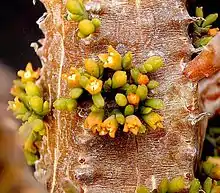 | |
| Viscum minimum leaf scales and flowers emerging from the host plant. | |
| Scientific classification | |
| Kingdom: | Plantae |
| Clade: | Tracheophytes |
| Clade: | Angiosperms |
| Clade: | Eudicots |
| Order: | Santalales |
| Family: | Santalaceae |
| Genus: | Viscum |
| Species: | V. minimum |
| Binomial name | |
| Viscum minimum | |
Description
In its native habitat Viscum minimum uses two species of succulents, Euphorbia polygona and Euphorbia horrida, as host plants. However, given the opportunity, the plant uses a range of succulents, including cacti, as hosts.
A mature Viscum minimum consists mostly of haustoria within the host plant, but a small stems of less than one millimeter in length with a single whorl of 2-3 scale-like leaves. A single flower, and later a red round fruit with a diameter of 8-9 millimeters, emerges from these stems. The leaves and stems are capable of photosynthesis, making the plant technically a hemiparasite.
The Viscum minimum mitochondrial genome has been sequenced, showing an unusual loss of genes or their functions. [1]
Seed germination
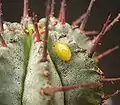 Day 1: The sticky seed has landed on the host plant.
Day 1: The sticky seed has landed on the host plant.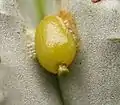 Day 4: Germination has commenced.
Day 4: Germination has commenced. Day 10: The shoot emerges from the seed.
Day 10: The shoot emerges from the seed.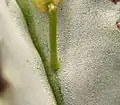 Day 23: The shoot has made contact with the host plant.
Day 23: The shoot has made contact with the host plant.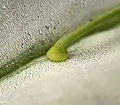 Day 30: The primary haustorium has developed.
Day 30: The primary haustorium has developed.
Literature
- William Henry Harvey: Flora Capensis 2: 581
- Robert Allen Dyer: Two Rare Parasites on Succulent Species of Euphorbia, Euphorbia Review Vol. I (4): 29-32, 1935
- Thomas Goebel: Viscum minimum Harvey in der Sukkulentensammlung der Stadt Zürich, Kakteen und andere Sukkulenten 29 (1), 1978
- Frank K. Horwood: Two parasites of Euphorbia: Viscum minimum and Hydnora africana, The Euphorbia Journal, Vol 1: 45-48, 1983
References
- Massive gene loss in mistletoe (Viscum, Viscaceae) mitochondria Nature Accessed 5.1.2018